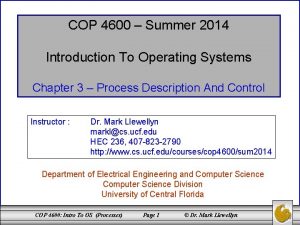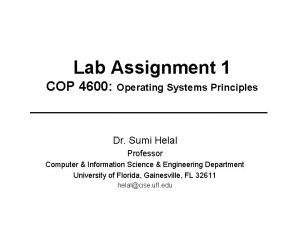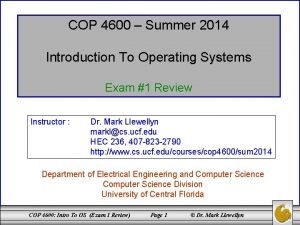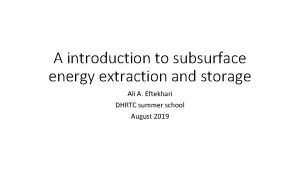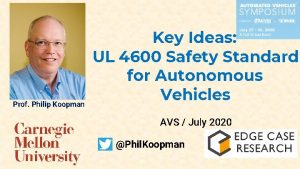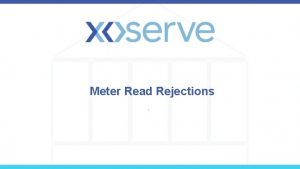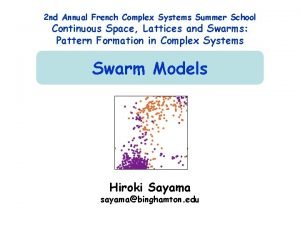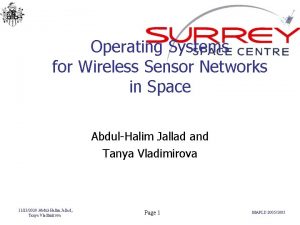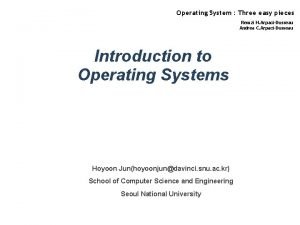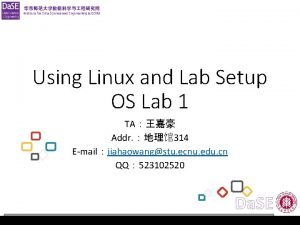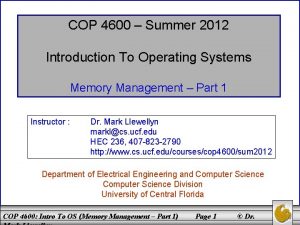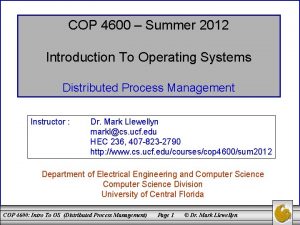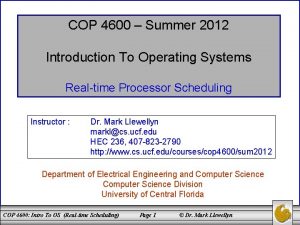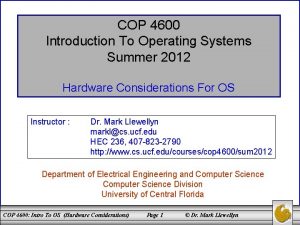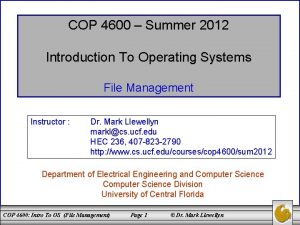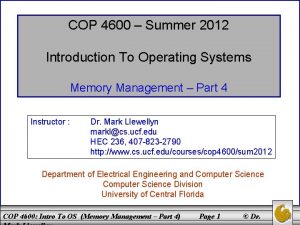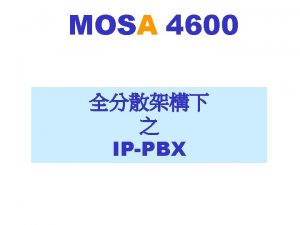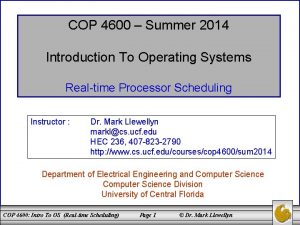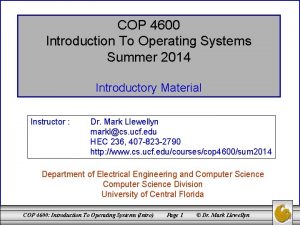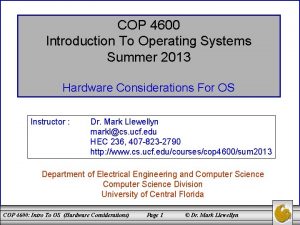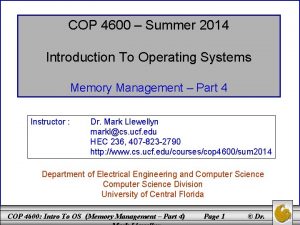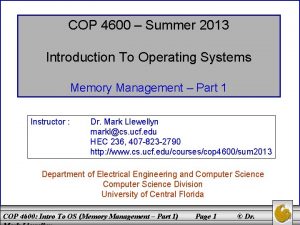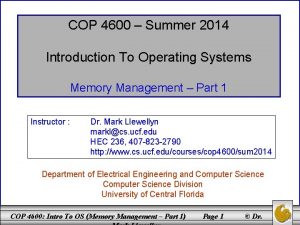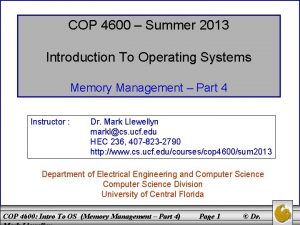COP 4600 Summer 2012 Introduction To Operating Systems


















- Slides: 18

COP 4600 – Summer 2012 Introduction To Operating Systems Final Exam Review Instructor : Dr. Mark Llewellyn markl@cs. ucf. edu HEC 236, 407 -823 -2790 http: //www. cs. ucf. edu/courses/cop 4600/sum 2012 Department of Electrical Engineering and Computer Science Division University of Central Florida COP 4600: Intro To OS (Final Exam Review) Page 1 © Dr. Mark Llewellyn

Material Covered On Exam • Material from exam #1 and exam #2. Review the exams. • New material from: – Memory management – Parts 3 & 4 – Virtual memory (homework #3) – Distributed process management – Device Management (homework #4) – File Management • A total of 58 points on the exam (14 T/F-MC problems at 2 points each plus 3 work problems) are from new material. A total of 44 points on the exam (17 T/F-MC problems at 2 points each plus one work problem) are from old material (see exams 1 & 2 and homework 1 & 2). COP 4600: Intro To OS (Final Exam Review) Page 2 © Dr. Mark Llewellyn

Format of the Exam • The exam consists of 31 T/F – MC questions and 4 work problems. • The work problem from the previous exams deals with processor scheduling. • The work problems similar to those on Homework 3, deal with paging algorithms and determining page faults. • The work problems similar to those on Homework 4, deal with disk scheduling algorithms. COP 4600: Intro To OS (Final Exam Review) Page 3 © Dr. Mark Llewellyn

Sample Questions: 1. Given the reference string shown below, determine the number of page faults that occur for this reference string when a FIFO page replacement policy is used with both a three and a four frame allocation. ref. string = 1, 3, 5, 4, 3, 2, 5, 6, 5, 4, 3, 4, 2, 3, 4, 5, 6, 2, 3, 4 2. Given the reference string shown below, determine the number of page faults that occur for this reference string when a LRU page replacement policy is used with both a three and a four frame allocation. ref. string = 1, 3, 5, 4, 3, 2, 5, 6, 5, 4, 3, 4, 2, 3, 4, 5, 6, 2, 3, 4 3. Given the reference string shown below, determine the number of page faults that occur for this reference string when the Optimal page replacement policy is used with both a three and a four frame allocation. ref. string = 1, 3, 5, 4, 3, 2, 5, 6, 5, 4, 3, 4, 2, 3, 4, 5, 6, 2, 3, 4 COP 4600: Intro To OS (Final Exam Review) Page 4 © Dr. Mark Llewellyn

Sample Questions: 4. • A process has associated with it the following table. • • For each logical address shown indicate if the address is legal. If it is, compute the physical address. Page # Addresses are in the form <p, d>. 0 Assume each page/frame is 1000 bytes in size. Frame # 32 1 18 2 3 3 45 Logical Address < 0, 321 > Is it legal? ______ Physical Address _______ Logical Address < 1, 3100 > Is it legal? ______ Physical Address ______ Logical Address < 4, 754 > Is it legal? ______ Physical Address ______ Logical Address < 2, 208 > Is it legal? ______ Physical Address ____ Logical Address < 3, 0 > Is it legal? ______ Physical Address ______ COP 4600: Intro To OS (Final Exam Review) Page 5 © Dr. Mark Llewellyn

Sample Questions: 5. Given the following table of processes, their arrival times, processing times, and priority, construct Gantt charts for each of the following processor scheduling protocols and determine for each protocol, the average turnaround time, average normalized turnaround time, and the average waiting time. Do this for the protocols: (a) FCFS, (b) SPN, (c) RR with time quantum = 1, (d) non-preemptive priority, and (e) preemptive priority. Process Arrival Time Processing Time Priority A 0 10 4 B 2 3 2 C 4 2 3 D 6 4 3 E 8 5 1 COP 4600: Intro To OS (Final Exam Review) Page 6 © Dr. Mark Llewellyn

Sample Questions: 6. Given the following sequence of disk track requests, and assuming that the read/write head is current positioned on track 50 (tracks numbered 0 -199) and moving toward larger track numbers (toward the center of the disk), determine the total number of tracks traversed in accommodating all of the requests using the (a) the SSTF disk scheduling algorithm and (b) the C-SCAN disk scheduling algorithm. 20, 44, 116, 98, 178, 35, 99, 122, 156 COP 4600: Intro To OS (Final Exam Review) Page 7 © Dr. Mark Llewellyn

Sample Questions: ANSWERS Question 1 FIFO 1 3 5 4 3 2 5 6 5 4 3 4 2 3 4 5 6 2 3 4 1 1 3 3 5 5 4 2 6 5 5 4 4 4 3 2 2 5 6 3 3 5 5 4 4 2 6 5 4 4 3 3 3 2 5 5 6 3 5 4 4 2 2 6 5 4 3 3 2 2 2 5 6 6 3 4 total faults frame Ref. String 2 3 page fault Y Y Y Y N Y N N Y Y 14 Ref. String 1 3 5 4 3 2 5 6 5 4 3 4 2 3 4 5 6 6 3 4 1 1 1 3 3 5 5 5 4 4 4 2 2 6 3 3 5 5 4 4 4 2 2 2 6 6 3 5 5 5 4 4 2 2 2 6 6 6 3 3 5 4 4 2 2 6 6 6 3 3 3 5 5 4 total faults Y N Y N N N Y 9 frame FIFO 2 3 4 page fault Y Y Y COP 4600: Intro To OS (Final Exam Review) Page 8 © Dr. Mark Llewellyn

Sample Questions: ANSWERS Question 2 LRU 1 3 5 4 3 2 5 6 5 4 3 4 2 3 4 5 6 2 3 4 1 1 3 5 4 3 2 2 6 5 5 3 4 2 3 4 5 6 2 3 3 5 4 3 2 5 6 5 4 3 4 2 3 4 5 6 2 3 4 total faults frame Ref. String 2 3 page fault Y Y N Y N N Y Y Y 15 Ref. String 1 3 5 4 3 2 5 6 5 4 3 4 2 3 4 5 6 2 3 4 1 1 1 5 4 3 3 2 6 6 5 5 5 2 3 4 5 6 3 3 3 5 4 3 2 2 6 5 5 3 4 2 3 4 5 6 2 5 5 4 3 2 5 6 5 4 3 4 2 3 4 5 6 2 3 4 total faults Y Y Y N Y N N N Y Y 14 frame LRU 2 3 4 page fault Y Y Y COP 4600: Intro To OS (Final Exam Review) Page 9 © Dr. Mark Llewellyn

Sample Questions: ANSWERS Question 3 Optimal 1 3 5 4 3 2 5 6 5 4 3 4 2 3 4 5 6 2 3 4 1 1 3 3 2 2 6 5 5 6 6 2 2 2 5 4 2 2 2 3 3 4 4 4 6 6 3 4 4 3 4 3 3 5 5 5 4 4 4 3 3 6 3 4 4 total faults frame Ref. String 2 3 page fault Y Y N Y N Y N N Y Y Y N N 11 Ref. String 1 3 5 4 3 2 5 6 5 4 3 4 2 3 4 5 6 2 3 4 1 1 1 2 2 6 6 6 2 2 5 2 2 2 3 5 4 3 3 5 5 5 3 4 5 4 6 6 6 3 5 4 4 3 4 4 5 3 4 3 3 3 5 5 4 3 3 4 5 3 6 3 4 4 total faults Y N Y N N N Y Y N N 9 frame Optimal 2 3 4 page fault Y Y Y COP 4600: Intro To OS (Final Exam Review) Page 10 © Dr. Mark Llewellyn

Sample Questions: ANSWERS Question 4 • A process has associated with it the following table. • • For each logical address shown indicate if the address is legal. If it is, compute the physical address. Page # Addresses are in the form <p, d>. 0 Assume each page/frame is 1000 bytes in size. Frame # 32 1 18 2 5 3 45 Logical Address < 0, 321 > Legal – physical address = (32 * 1000 + 321) = 32, 321 Logical Address < 1, 3100 > Illegal - displacement of 3100 is larger than 1000 byte page size Logical Address < 5, 754 > Illegal – process has no page 5 in the page table Logical Address < 2, 208 > Legal – physical address = (5 * 1000 + 208) = 5208 Logical Address < 3, 0 > Legal – physical address = (45 * 1000 + 0) = 45, 000 COP 4600: Intro To OS (Final Exam Review) Page 11 © Dr. Mark Llewellyn

Sample Questions: ANSWERS Question 5 - FCFS Process TR TR / T S wait time A 10 1 0 11 3. 666667 8 11 5. 5 9 13 3. 25 9 16 3. 2 11 12. 2 3. 323333 7. 4 B C D E w w w w w w w w w w 0 1 2 3 4 5 6 7 8 9 10 11 12 13 14 15 16 17 18 19 20 21 22 23 24 COP 4600: Intro To OS (Final Exam Review) Page 12 © Dr. Mark Llewellyn average

Sample Questions: ANSWERS Question 5 - SPN Process TR TR / T S wait time A 10 1 0 B w w w w w 13 4. 333333 10 C w w w 8 4 6 13 3. 25 9 16 3. 2 11 12 3. 156667 7. 2 D E w w w w w 0 1 2 3 4 5 6 7 8 9 10 11 12 13 14 15 16 17 18 19 20 21 22 23 24 COP 4600: Intro To OS (Final Exam Review) Page 13 © Dr. Mark Llewellyn average

Sample Questions: ANSWERS Question 5 – RR, q = 1 Process A B C D E w w w w w w w w w w 0 1 2 3 4 5 6 7 8 9 10 11 12 13 14 15 16 17 18 19 20 21 22 23 24 COP 4600: Intro To OS (Final Exam Review) Page 14 TR TR / T S wait time 24 2. 4 14 8 2. 666667 5 7 3. 5 5 12 3 8 13 2. 6 8 12. 833333 8 © Dr. Mark Llewellyn average

Sample Questions: ANSWERS Question 5 – priority – non-preemptive Priority - non-preemptive Process TR TR / T S wait time A 10 1 0 16 5. 333333 13 16 8 14 18 4. 5 14 7 1. 4 2 13. 4 4. 046667 8. 6 B C D E w w w w w w w w w w w 0 1 2 3 4 5 6 7 8 9 10 11 12 13 14 15 16 17 18 19 20 21 22 23 24 COP 4600: Intro To OS (Final Exam Review) Page 15 © Dr. Mark Llewellyn average

Sample Questions: ANSWERS Question 5 – priority – preemptive Priority - preemptive Process A w w w w B C D w w w w E 0 1 2 3 4 5 6 7 8 9 10 11 12 13 14 15 16 17 18 19 20 21 22 23 24 COP 4600: Intro To OS (Final Exam Review) Page 16 TR TR / T S wait time 24 2. 4 14 3 1 0 3 1. 5 1 10 2. 5 6 5 1 0 9 1. 68 4. 2 © Dr. Mark Llewellyn average

Sample Questions: ANSWERS Question 6(a) - SSTF Next track accessed Number of tracks traversed Cumulative tracks traversed 44 6 6 35 9 15 20 15 30 98 78 108 99 1 109 116 17 126 122 6 132 156 34 166 178 22 188 Average number of tracks traversed = 20. 89 COP 4600: Intro To OS (Final Exam Review) Page 17 © Dr. Mark Llewellyn

Sample Questions: ANSWERS Question 6(b) – C-SCAN Next track accessed Number of tracks traversed Cumulative tracks traversed 98 48 48 99 1 49 116 17 66 122 6 72 156 34 106 178 22 128 178 -199, 199 -0 221 349 20 20 369 35 15 384 44 9 393 Average number of tracks traversed = 43. 67 COP 4600: Intro To OS (Final Exam Review) Page 18 © Dr. Mark Llewellyn
 Cop 4600
Cop 4600 Cop 4600
Cop 4600 Cop 4600 ucf
Cop 4600 ucf Good cop bad cop interrogation
Good cop bad cop interrogation Cop 1 cop 2
Cop 1 cop 2 Earth 4600 million years ago
Earth 4600 million years ago Ul 4600
Ul 4600 4600/365
4600/365 4600 miles
4600 miles Introduction to operating systems
Introduction to operating systems Complex systems summer school
Complex systems summer school Examples of operating system.
Examples of operating system. Evolution of operating systems
Evolution of operating systems Components of operating systems
Components of operating systems Operating system components
Operating system components Wsn operating systems
Wsn operating systems Operating systems three easy pieces
Operating systems three easy pieces Operating system lab
Operating system lab Andrew tanenbaum modern operating systems
Andrew tanenbaum modern operating systems
